基于双三唑甲烷的两种新型Cu髤配合物的结构和性质_英文_田丽
以甲氧基苯甲酸为配体的两个双核铜配合物的合成、晶体结构和理论计算
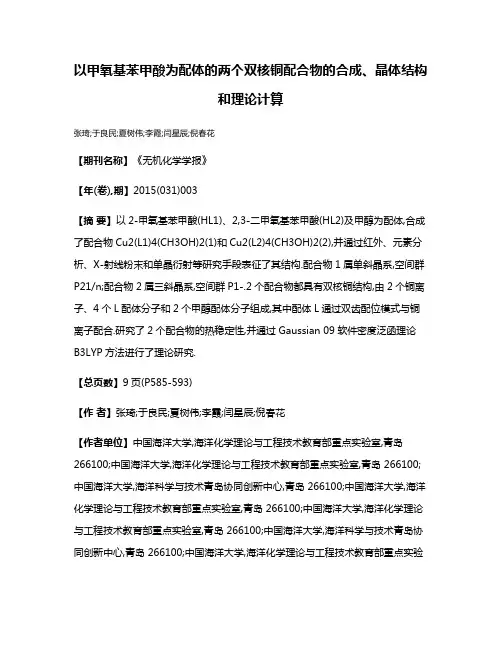
以甲氧基苯甲酸为配体的两个双核铜配合物的合成、晶体结构和理论计算张琦;于良民;夏树伟;李霞;闫星辰;倪春花【期刊名称】《无机化学学报》【年(卷),期】2015(031)003【摘要】以2-甲氧基苯甲酸(HL1)、2,3-二甲氧基苯甲酸(HL2)及甲醇为配体,合成了配合物Cu2(L1)4(CH3OH)2(1)和Cu2(L2)4(CH3OH)2(2),并通过红外、元素分析、X-射线粉末和单晶衍射等研究手段表征了其结构.配合物1属单斜晶系,空间群P21/n;配合物2属三斜晶系,空间群P1-.2个配合物都具有双核铜结构,由2个铜离子、4个L配体分子和2个甲醇配体分子组成,其中配体L通过双齿配位模式与铜离子配合.研究了2个配合物的热稳定性,并通过Gaussian 09软件密度泛函理论B3LYP方法进行了理论研究.【总页数】9页(P585-593)【作者】张琦;于良民;夏树伟;李霞;闫星辰;倪春花【作者单位】中国海洋大学,海洋化学理论与工程技术教育部重点实验室,青岛266100;中国海洋大学,海洋化学理论与工程技术教育部重点实验室,青岛 266100;中国海洋大学,海洋科学与技术青岛协同创新中心,青岛 266100;中国海洋大学,海洋化学理论与工程技术教育部重点实验室,青岛 266100;中国海洋大学,海洋化学理论与工程技术教育部重点实验室,青岛 266100;中国海洋大学,海洋科学与技术青岛协同创新中心,青岛 266100;中国海洋大学,海洋化学理论与工程技术教育部重点实验室,青岛 266100;中国海洋大学,海洋化学理论与工程技术教育部重点实验室,青岛266100【正文语种】中文【中图分类】O614.121【相关文献】1.基于3,5-二((4′-羧基苄基)氧)苯甲酸和4′-(4-吡啶基)-2,2′∶6′,2″-三联吡啶为混合配体的两个配合物的水热合成与晶体结构 [J], 乔宇;尉兵;王璐瑶;李秀颖;车广波;刘春波;张兴晶2.两个由2-(4 '-氯-苯甲酰基)苯甲酸和双咪唑基配体构筑的锰、镉配合物的合成及晶体结构 [J], 李国峰;李秀梅;纪建业;牛艳玲;王庆伟3.以邻氯苯甲酸及联吡啶为配体的双核铜配合物的水热合成、晶体结构及量子化学研究 [J], 石智强;季宁宁;何国芳;韩银锋4.两个由双咪唑基配体构筑的镉配合物的合成、晶体结构及理论计算 [J], LI Xiu-Mei;PAN Ya-Ru;LIU Bo;ZHOU Shi5.两个含有2,6-二氟苯甲酸配体稀土配合物的合成及晶体结构 [J], 彭雄鑫; 王文敏; 钟宇菲; 肖伟; 鲍光明; 袁厚群因版权原因,仅展示原文概要,查看原文内容请购买。
两种1,2,3-三唑衍生物的配合物合成策略:晶体结构和表面分析
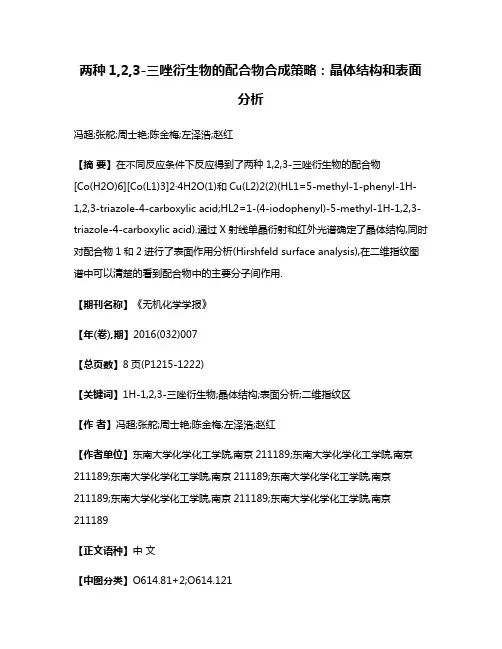
两种1,2,3-三唑衍生物的配合物合成策略:晶体结构和表面分析冯超;张舵;周士艳;陈金梅;左泽浩;赵红【摘要】在不同反应条件下反应得到了两种1,2,3-三唑衍生物的配合物[Co(H2O)6][Co(L1)3]2·4H2O(1)和Cu(L2)2(2)(HL1=5-methyl-1-phenyl-1H-1,2,3-triazole-4-carboxylic acid;HL2=1-(4-iodophenyl)-5-methyl-1H-1,2,3-triazole-4-carboxylic acid).通过X射线单晶衍射和红外光谱确定了晶体结构,同时对配合物1和2进行了表面作用分析(Hirshfeld surface analysis),在二维指纹图谱中可以清楚的看到配合物中的主要分子间作用.【期刊名称】《无机化学学报》【年(卷),期】2016(032)007【总页数】8页(P1215-1222)【关键词】1H-1,2,3-三唑衍生物;晶体结构;表面分析;二维指纹区【作者】冯超;张舵;周士艳;陈金梅;左泽浩;赵红【作者单位】东南大学化学化工学院,南京211189;东南大学化学化工学院,南京211189;东南大学化学化工学院,南京211189;东南大学化学化工学院,南京211189;东南大学化学化工学院,南京211189;东南大学化学化工学院,南京211189【正文语种】中文【中图分类】O614.81+2;O614.121The construction of coordination compounds with intriguing structuralmotifsand functionalbehaviorshas attracted considerable attention for chemists[1-5].During the past years,a substantial amount ofwork based on coordination assembled systems has emerged,which enrich the inorganic-organic hybrid materials with novel networks and properties[6-11].From the standpoint of synthetic methodology,the access to such multicomponent supramolecular systems mainly depends upon the selection of appropriate chemical building blocks.Meanwhile,1-substituted-1,2,3-triazole-4-carboxylic acid have played as good building blocks in constructing supramolecular architectures[12-14],and our group have chosen a pyridyl conjugated 1,2,3-triazole ligand 5-methyl-1-(pyridine-3-yl)-1H-1,2,3-triazole-4-carboxylic acid asorganic ligand and resulted series ofnew coordination polymers previously[15].Due to the flexible nature of the carboxyl group,1-substituted-1,2,3-triazole-4-carboxylic acid ligands may exhibit kinds of conformations in different complexes to meet the requirements of coordination geometry.Besides, the self-assembly processes are usually influenced by many other factors such as the coordination geometry of metal ion,temperature,counter anion,pH value, and solventmedium[16-20].As our ongoing task,studying the influences of substituent triazole ligands,herein,we synthesized two kinds of 1-substituted-1,2,3-triazole-4-carboxylic acid according to different design concepts.Firstly,the phenyl was introduced to the 1-position of triazole acid,and 5-methyl-1-phenyl-1H-1,2,3-triazole-4-carboxylic acid(HL1)was obtained.In order toinvestigate the influence of the electron-withdrawing group on coordination ability,the iodo-group was decorated to the benzenering,which resulted in 1-(4-iodophenyl)-5-methyl-1H-1,2,3-triazole-4-carboxylic acid(HL2).We also synthesized two new complexes[Co(H2O)6][Co(L1)3]2·4H2O(1),Cu(L2)2(2).For the purpose of investigating the intermolecular interactions of complexes,we also study the Hirshfeld surface analysis for 1 and 2.1.1 Materials and measurementsAll reagents and solvents were obtained from commercial sources and used without further purification.The ligandswere synthesized according to literatures[21].Elemental analyses of carbon,hydrogen, and nitrogen were carried out with a Perkin-Elmer 240Celementalanalyzer.IR spectrawereobtained with KBr pellets from 4 000 to400 cm-1usinga Nicolet5700 spectrophotometer.Crystal structures were determined with Rigaku SCXminidiffractometer.1.2 Preparations1.2.1 [Co(H2O)6][Co(L1)3]2·4H2O(1)A solution of CoCl2·6H2O(0.023 8 g,0.1 mmol) in water(8 m L)was added into a solution of HL1(0.040 6 g,0.2 mmol)in anhydrous ethanol(8 mL), then the mixture was left at room temperature.After one week,red block crystals were obtained and dried in air.Yield:42%(based onCoCl2·6H2O).Anal. Calcd.for C60H68Co3N18O22(%):C,45.86;H,4.33;N, 16.05.Found(%):C,45.78;H,4.41;N,16.01.IR (KBr,cm-1):3 440(w),1 618(s),1 600(vs),1 582 (s),1 563(m),1 485(m),1 403(w),1 365(m),1 323 (s),1 300(m),1241(m),1 133(m),830(m),766(m).1.2.2 Cu(L2)2(2)The synthesis of complex 2 is similar with 1,just using CuCl2·2H2O(0.017 2 g,0.1 mmol)and HL2(0.065 6 g,0.2mmol)instead of CoCl2·6H2O and HL1. Yield:46%(based on CuCl2·2H2O).Anal.Calcd.forC40H28Cu2I2N12O8(%):C,33.35;H,1.95;N,11.67.Found(%):C,33.12;H,2.02;N,11.71.IR(KBr; cm-1):3 440(w),1 621(s),1 605(s),1 492(m),1 421 (s),1 370(m),1 303(s),1 309(m),1 240(m),1 136(m), 1018(w),830(m),and 755(m).1.3 Crystal structure determ inationSingle-crystal X-ray diffraction measurements for complexes were carried out using a Rigaku SCX mini diffractometer with Mo Kαradiation(λ=0.071 073 nm).The c rystal size is 0.23 mm×0.21 mm×0.20 mmfor 1 and0.25mm×0.23mm×0.20 mm for 2.The structure was solved by directmethodswith SHELXS-97 and refined by full-matrix least-squares on F2with SHELXL-97[22].All non-hydrogen atoms were refined with anisotropic displacement parameters.Hydrogen atoms were added theoretically and refined with riding model and fixed isotropic thermal parameters.The crystallographic parameters and structural determination of 1 and 2 are summarized in Table1. Selected bond lengths and bond angles of 1 and 2 are listed in Table2.CCDC:1400174,1;1400175,2.2.2 Com putational detailsMolecular Hirshfeld surface calculations were performed by using theCrystalExplorer program[23]. The principles of Hirshfeld surfaces were reported in the literature[23].When the cif files of 1 and 2 were read into the CrystalExplorer program for analysis,all bond lengths to hydrogen were automatically modified to typical standard neutron values(C-H 0.108 3 nm and N-H 0.100 9 nm).In this study,all the Hirshfeld surfaces were generated using a standard(high) surface resolution.The 2D fingerprint plots were displayed by using the standard 0.06~0.26 nm view with the deand didistance scales displayed on the graph axes.2.1 Crystal structural descriptionX-ray single crystal diffraction confirms the complex 1 crystallizes in triclinic system with P1 space group.The asymmetric unit of 1 consists of a [Co(L1)3]-anion,half[Co(H2O)6]2+counter cation and two lattice H2O molecules as shown in Fig.1.The Co(Ⅱ)cation of the[Co(L1)3]-anion is coordinated to three HL1ligands.Each ligand coordinated to theCo(Ⅱ)cation adopts the coordination mode of bidentate chelating.The coordination geometry around the Co(Ⅱ)is best described as a distorted octahedral geometry. The[Co(H2O)6]2+unit in 1 plays as a counter ion to balance the charge on the[Co(L1)3]-anion.The Co2 is surrounded by six water molecules,with the distance of Co2-O from 0.205 6(3)to 0.2102(3)nm.It gives a nearly standard octahedral geometry with water molecules on six vertexes.This similar counter ion is involved in many documents[24-25].It is surprisingly found that O atoms of[Co(H2O)6]2+are only electron donors,not acceptors.Hydrogen bonds of O7-H7B…O4i,O8-H8B…O3iiand O9-H9B···O1iii(Symmetry codes:i1-x,2-y,1-z,iix,y,-1+z,iii-x+1,-y+2, -z+1)between the discrete[Co(L1)3]-anions(A)and[Co(H2O)6]2+cations(B)form an[A-B-A]terminal. Each Crystallographic independent lattice water molecule(C)connected the[A-B-A]terminals into zigzag chains-[A-B-A]-[C]-[A-B-A]-through O-H…O hydrogenbonds(Fig.2,Table3),thus the supramolecular architecture of 1 is constructed.The crystal structure of 2 shows that each unit contains two(L2)-anions and one Cu.The local coordination geometry around Cu can be described as a slightly distorted quadrilateral(Fig.3).The Cu coordinates to two ligands with a Cu-O distance of 0.193 5(3)~0.196 0(3)nm and two triazole nitrogensof two(L2)-ligands in a trans fashion with Cu-N distance 0.1966(3)~0.197 8(3)nm.The O-Cu1-O1 angle is 174.85(14)°,whereas the N-Cu-O angle s around the Cu center range from 82.03(13)°to 97.43(13)°.In 2, the(L2)-is bidentate with one oxygen of carboxylate and one nitrogen of 1,2,3-triazole ring chelating to Cu, resulting in the formation of a stable five-numbered ring(Cu1-O1-C1-C2-N1)and it takes the coordination mode as bidentate chelating.In the crystal packing of 2,the coordinated O3 of carboxylate forms a strong contact(0.373 53(19)nm)with theiodine,resulting in a 1D zigzag chain,and adjacent chains formed into a 2D layer by C19…O2 contacts(Fig.4).In the 2D network,the Cu…Cu distances through intermolecular contacts are 1.239 1 and 1.354 4 nm,respectively.In addition,there also exists C-I…πstacking interactionswith a distance of0.3858(2)nm.2.2 Hirshfeld surface analysis for 1 and 2In order to compare the interactions in the crystal structures of compounds 1 and 2,the Hirshfeld surface analysis and the two-dimensional(2D) fingerprint plots generated,based on the deand didistances(deand diare the distances from the Hirshfeld surface to the nearest atom outside and inside the surface,respectively),were carried out using CrystalExplorer 2.0.This analysis shows that in both compounds,the intermolecular H…H contacts have a major contribution to the crystal packing(Fig. 5).These contacts comprise 37.6%and 18.8%of the total Hirshfeld surfaces of molecules 1 and 2, respectively.The shortest contacts of this type show up in the fingerprint plots as characteristic spikes.The structures are also dominated by O…H/H…O contacts which comprise 26.7%and 12.9%of total Hirshfeld surface areas as sharp pound 1 occupiesmore proportion of C…Hcontacts(18.0%)than 2,which contains only 16.2%.The structure of 1 is also dominated by N…H/H…N contacts which comprise 10.6%of total Hirshfeld surface areas. C ompared with 1,the contacts of I…H,I…O and I… N in 2 comprise 12.9%,6.4%and 5.2%,respectively.By comparison in Fig.6,compounds 1 and 2 have different cases about Hirshfeld surfaces.Two major differences are as follows.On the one hand,thedistributions of hydrogen bonds indicate that although both of 1 and 2 have H…H and O…H/H…O contacts,the interactionsmake bigger contributions to the whole Hirshfeld surface in 1.This may be raised from differentmolecular structures of both compounds, while 1 contains a counter cation and free water molecules,but 2 is very clear.On the otherhand,2 has I…X(X=H,O,and N)interactions.The reason for this phenomenon is still the special conformation in crystal structure of 2.This phenomenon indicates that through proper design principles,it can be possible to exploit the presumably weak interactions in the design of supramolecular architectures.The Hirshfeld surfaces certainly allow a much more detailed scrutiny by displaying all the intermolecular interactions within the crystal and this methodology has very important promise in crystal engineering.In summary,we have synthesized and structurally characterized two complexes with 1,2,3-triazole derivatives by rational designing.We further investigated the Hirshfeld surfaceofcomplexes 1 and 2, and surprisingly find that the main intermolecular interactions in the two complexes are O…H and H…H contacts.Moreover,higher dimensional supramolecular networks can further be achieved via hydrogen bonds and intermolecular close packing interactions. Accordingly,these resultsmay offer new insights into the design and assembly of such supramolecular crystals,and we believe that it could make a contribution to the strategy ofcrystalengineering.Acknow ledg ments:We gratefully acknowledge the financial support of the Fundamental Research Funds for Central Universities(GrantNo.3207045420)and the financial support from Jiangsu Ainaji Neoenergy Science&Technology Co.,Ltd(Grant No.8507040091).References:[1]Zhu Q L,Xu Q.Chem.Soc.Rev.,2014,43(16):5468-5512[2]Du M,Chen M,Wang X,et al.Inorg.Chem.,2014,53(14): 7074-7076[3]Mondal SS,Bhunia A,Kelling A,et al.J.Am.Chem.Soc., 2014,136(1):44-47[4]Suh M P,Park H J,Prasad T K,et al.Chem.Rev., 2012,112(2),782-835[5]Cui Y,Yue Y,Qian G,et al.Chem.Rev.,2012,112(2): 1126-1162[6]EddaoudiM,Sava D F,Eubank JF,et al.Chem.Soc.Rev., 2015,44(1):228-249[7]DVries R F,Iglesias M,Snejko N,et al.Inorg.Chem.,2012, 51(21):11349-11355[8]Du M,Li C P,Chen M,et al.J.Am.Chem.Soc.,2014,136 (31):10906-10909[9]Wang C,Liu D,Lin W.J.Am.Chem.Soc.,2013,135(36): 13222-13234[10]Horike S,Umeyama D,Kitagawa S.Acc.Chem.Res.,2013, 46(11):2376-2384[11]You W,Guo JH,Li C P,et al.Polyhedron,2015,91:104-109[12]Zhao H,Zhou SY,Feng C,et al.Inorg.Chim.Acta,2014, 421:169-175[13]Zhou S Y,Qu Z R,Ma H J,et anomet.Polym.,2014,24(3):656-663[14]Feng C,Gao G Y,Qu Z R,et anomet.Polym.,2015,25(5):1233-1238[15]Hong JL,Qu ZR,Ma H J,et al.Bull.Korean Chem.Soc., 2014,35(5):1495-1500[16]Wang X Y,Wang L,Wang Z M,et al.J.Am.Chem.Soc., 2006,128(3):674-675[17]Khavasi H R,Sadegh B M M.Inorg.Chem.,2010,49(12): 5356-5358[18]Fang S M,Zhang Q,Hu M,et al.Inorg.Chem.,2010,49 (20):9617-9626[19]Long LS.CrystEngComm,2010,12(5):1354-1365[20]Chen S C,Zhang Z H,Huang K L,et al.Cryst.Growth Des.,2008,8(9):3437-3445[21](a)Zhao H,Chen JM,Lin J R,et al.J.Coord.Chem., 2011,64(15):2735-2745(b)Wang G G,Zhao H.Acta Crystallogr.Sect.E,2010,E66: o3001[22]Sheldrick G M.SHELXL-97,Program for X-ray Crystal Structure Refinement,University of Göttingen,Göttingen, Germany,1997.[23]Wolff S K,Grimwood D J,McKinnon J J,et al. CrystalExplorer2.0,University ofWestern Australia,Perth, Australia,2007.[24]Worl S,Hellwinkel D,Pritzkow H,et al.Dalton Trans., 2004:2750-2757[25]Shiu K B,Yen C H,Liao F L,et al.Acta Crystallogr.Sect. E,2004,E60:m35。
含联苯三羧酸及二咪唑基吡啶配体的两个锌配位聚合物的合成、结构及荧光性质
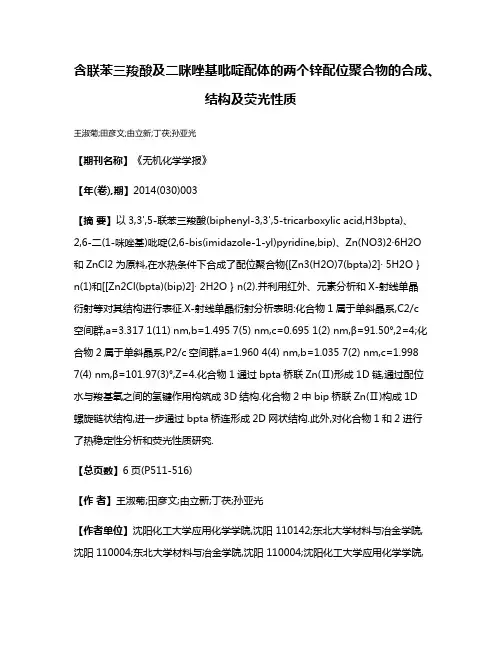
含联苯三羧酸及二咪唑基吡啶配体的两个锌配位聚合物的合成、结构及荧光性质王淑菊;田彦文;由立新;丁茯;孙亚光【期刊名称】《无机化学学报》【年(卷),期】2014(030)003【摘要】以3,3',5-联苯三羧酸(biphenyl-3,3',5-tricarboxylic acid,H3bpta)、2,6-二(1-咪唑基)吡啶(2,6-bis(imidazole-1-yl)pyridine,bip)、Zn(NO3)2·6H2O和ZnCl2为原料,在水热条件下合成了配位聚合物{[Zn3(H2O)7(bpta)2]· 5H2O}n(1)和[[Zn2Cl(bpta)(bip)2]· 2H2O}n(2).并利用红外、元素分析和X-射线单晶衍射等对其结构进行表征.X-射线单晶衍射分析表明:化合物1属于单斜晶系,C2/c空间群,a=3.317 1(11) nm,b=1.495 7(5) nm,c=0.695 1(2) nm,β=91.50°,2=4;化合物2属于单斜晶系,P2/c空间群,a=1.960 4(4) nm,b=1.035 7(2) nm,c=1.9987(4) nm,β=101.97(3)°,Z=4.化合物1通过bpta桥联Zn(Ⅱ)形成1D链,通过配位水与羧基氧之间的氢键作用构筑成3D结构.化合物2中bip桥联Zn(Ⅱ)构成1D螺旋链状结构,进一步通过bpta桥连形成2D网状结构.此外,对化合物1和2进行了热稳定性分析和荧光性质研究.【总页数】6页(P511-516)【作者】王淑菊;田彦文;由立新;丁茯;孙亚光【作者单位】沈阳化工大学应用化学学院,沈阳 110142;东北大学材料与冶金学院,沈阳 110004;东北大学材料与冶金学院,沈阳 110004;沈阳化工大学应用化学学院,沈阳 110142;沈阳化工大学应用化学学院,沈阳 110142;沈阳化工大学应用化学学院,沈阳 110142【正文语种】中文【中图分类】O614.24+1【相关文献】1.基于3,5-吡啶二羧酸和双咪唑配体构筑的锌(Ⅱ)配位聚合物的合成、晶体结构及其荧光性质 [J], 王莉;李少华;王瑞雪;李楠楠;刘斌;袁粉粉;王帅;闫彬2.基于3,3',5,5'-(1,3-苯基)-联苯四羧酸配体构筑的具有四重dmd穿插结构的锌配位聚合物的合成、晶体结构和荧光性质 [J], 王记江;侯向阳;高楼军;张美丽;任宜霞;付峰3.以4’-羟基-联苯-4-羧酸和1,3-二(4-吡啶基)丙烷构筑的一维锌配位聚合物的晶体结构与荧光性质 [J], 刘道森;梁法库;王志武4.苯基多羧酸及含氮配体构筑的三维框架结构锌配位聚合物的合成、晶体结构和荧光性质 [J], 汪鹏飞;方勤;吴国志;汪新5.由咪唑-4,5-二羧酸和1,4-双(咪唑基-1-甲基)-苯配体构筑的一个三维镉(Ⅱ)配位聚合物的合成、晶体结构及荧光性质 [J], 刘宏文;卢文贯因版权原因,仅展示原文概要,查看原文内容请购买。
新型苦味酸铜(Ⅱ)配合物的合成、晶体结构及其热性能
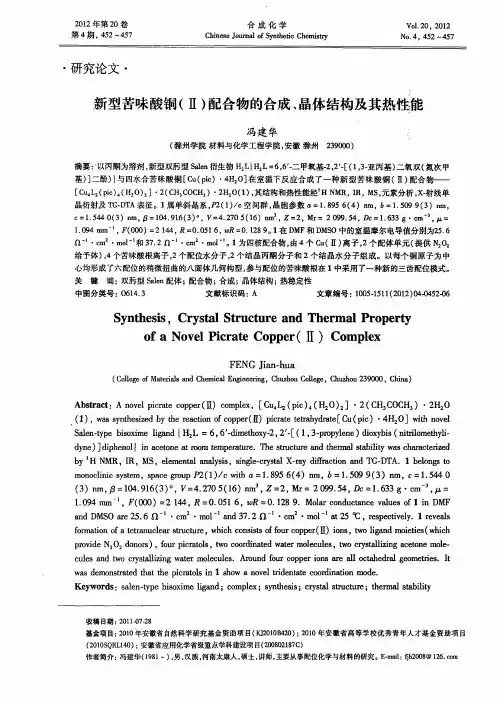
晶衍射及 T -T GD A表征 。1 属单斜 晶系 ,2 1/ 空间群 , P ( )c 晶胞参数 a 1856 4 nl b 1599 3 u , = .9 ( ) l, = .0 ( )l T n
c 15 40 3 m, =14 9 6 3 。 V= .7 ( 6 m , = .4 ( )a 0 .1 ( ) , 4 2 05 1 )a . z=2 Mr 9 .4, e .3 c 3 , =20 95 D =16 3g・ m一, = 10 4l .9 m~, ( 0 )= 4 , 0 0 1 , R= .2 。 在 D n F 0 0 21 R= .5 w 0 18 1 6 9 MF和 D S M O中的室温摩尔 电导值分别为2 . 56
Q~ ・m t l e ・ o o 和 3. 72Q~ ・ n ・ o~。 为四核配合物 , 4 C ( 离子 , 个 配体单元 ( c tl 1 l o 由 个 o Ⅱ) 2 提供 N0 22
给予体)4 , 个苦味酸根离子 ,个配位水分子 ,个结晶丙酮分子和 2 2 2 个结晶水分子组成。以每个铜原子为中
・
研 究论文 ・
新型苦味酸铜 ( 配合物的合成 、 Ⅱ) 晶体结构及其热性能
冯建华
( 滁州学 院 材料与化学工程学院 , 安徽 滁州 2 9 0 ) 3 00 摘要 :以丙酮为溶剂 , 型双肟型 Sl ’ 新 ae n衍生物 H L{ : 6 6- H L= , 二甲氧基 ., [ 13亚丙基 ) 氧双( 2 2一 ( ,- 二 氮次 甲
S n h ss y t e i ,Cr sa tu t e a e m a o e t y t lS r cur nd Th r lPr p r y
o oe PcaeC p e ( f N vl i t o p r Ⅱ)C mpe a r o l x
双三唑和双功能四唑配体的金属-有机骨架材料的合成和性质研究的开题报告
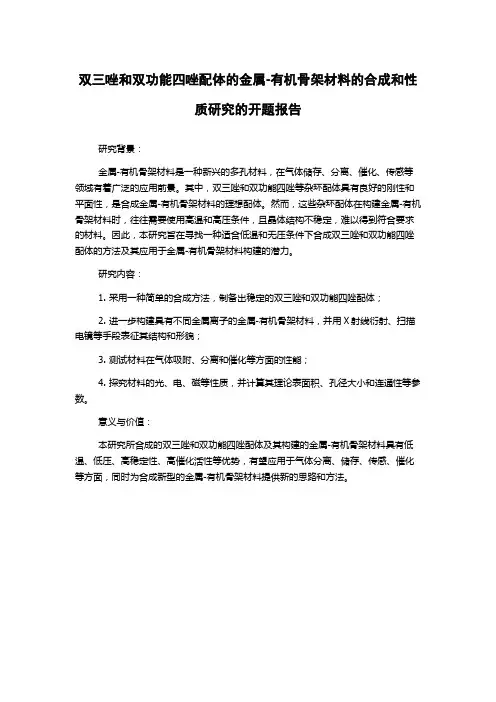
双三唑和双功能四唑配体的金属-有机骨架材料的合成和性
质研究的开题报告
研究背景:
金属-有机骨架材料是一种新兴的多孔材料,在气体储存、分离、催化、传感等领域有着广泛的应用前景。
其中,双三唑和双功能四唑等杂环配体具有良好的刚性和平面性,是合成金属-有机骨架材料的理想配体。
然而,这些杂环配体在构建金属-有机骨架材料时,往往需要使用高温和高压条件,且晶体结构不稳定,难以得到符合要求的材料。
因此,本研究旨在寻找一种适合低温和无压条件下合成双三唑和双功能四唑配体的方法及其应用于金属-有机骨架材料构建的潜力。
研究内容:
1. 采用一种简单的合成方法,制备出稳定的双三唑和双功能四唑配体;
2. 进一步构建具有不同金属离子的金属-有机骨架材料,并用X射线衍射、扫描电镜等手段表征其结构和形貌;
3. 测试材料在气体吸附、分离和催化等方面的性能;
4. 探究材料的光、电、磁等性质,并计算其理论表面积、孔径大小和连通性等参数。
意义与价值:
本研究所合成的双三唑和双功能四唑配体及其构建的金属-有机骨架材料具有低温、低压、高稳定性、高催化活性等优势,有望应用于气体分离、储存、传感、催化等方面,同时为合成新型的金属-有机骨架材料提供新的思路和方法。
基于3,5-双(4-吡啶基)-吡啶的两个钴(Ⅱ)配合物的合成与晶体结构
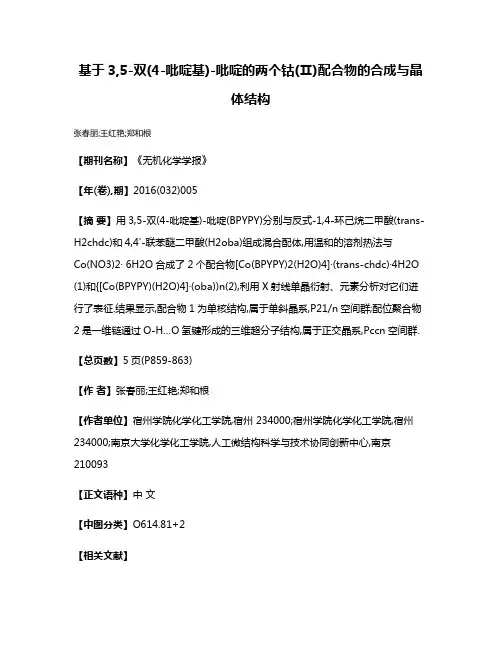
基于3,5-双(4-吡啶基)-吡啶的两个钴(Ⅱ)配合物的合成与晶体结构张春丽;王红艳;郑和根【期刊名称】《无机化学学报》【年(卷),期】2016(032)005【摘要】用3,5-双(4-吡啶基)-吡啶(BPYPY)分别与反式-1,4-环己烷二甲酸(trans-H2chdc)和4,4'-联苯醚二甲酸(H2oba)组成混合配体,用温和的溶剂热法与Co(NO3)2· 6H2O合成了2个配合物[Co(BPYPY)2(H2O)4]·(trans-chdc)·4H2O (1)和{[Co(BPYPY)(H2O)4]·(oba))n(2),利用X射线单晶衍射、元素分析对它们进行了表征.结果显示,配合物1为单核结构,属于单斜晶系,P21/n空间群;配位聚合物2是一维链通过O-H…O氢键形成的三维超分子结构,属于正交晶系,Pccn空间群.【总页数】5页(P859-863)【作者】张春丽;王红艳;郑和根【作者单位】宿州学院化学化工学院,宿州 234000;宿州学院化学化工学院,宿州234000;南京大学化学化工学院,人工微结构科学与技术协同创新中心,南京210093【正文语种】中文【中图分类】O614.81+2【相关文献】1.两个基于双(4-吡啶-4-苯基)胺的钴(Ⅱ)、锌(Ⅱ)配合物的合成和晶体结构 [J], 张春丽;郑和根2.基于3,5-二((4′-羧基苄基)氧)苯甲酸和4′-(4-吡啶基)-2,2′∶6′,2″-三联吡啶为混合配体的两个配合物的水热合成与晶体结构 [J], 乔宇;尉兵;王璐瑶;李秀颖;车广波;刘春波;张兴晶3.1H-3-(3-吡啶基)-5-(3'-吡啶基)-1,2,4-三唑的钴(Ⅱ)配合物的合成、晶体结构、热稳定性及配体的DFT计算 [J], 孙琳;刘怀贤;周惠良;刘翔宇;宋伟明;李冰;胡奇林4.含有4-对溴苯基-3,5-二(2-吡啶基)-1,2,4-三氮唑钴配合物的合成,晶体结构和磁性 [J], 齐丽;朱敦如;解大景;吴艳飞;沈旋5.新的二[4-对甲基苯基-3,5-二(2-吡啶基)-1,2,4-三氮唑]双硫氰根合锰配合物的合成,晶体结构和磁性 [J], 朱敦如;王天维;仲盛来;许岩;游效曾因版权原因,仅展示原文概要,查看原文内容请购买。
含双二苯基膦甲烷双核铜(i)配合物的合成及性质
在《刺激响应吡啶三氮唑铜(Ⅰ)发光配合物的合成与表征》文中研究指明刺激响应发光材料因在光学传感、环境检测、信息存储和安全保护等方面的良好潜在应用而备受关注。
因此,应用铜(Ⅰ)配合物来发展刺激响应发光材料具有非常重要的理论研究意义和实际应用价值。
本论文应用吡啶三氮唑基螯合配体,结合有机辅助膦配体(双(二苯基膦)甲烷和N,N-双(二苯基膦)胺),设计合成了两类刺激响应铜(Ⅰ)发光配合物,并对它们的结构和性能进行了系统研究。
具体研究内容如下:1.应用5-叔丁基-3-(2’-吡啶基)-1,2,4-三氮唑(bptzH)和双(二苯基膦)甲烷(dppm),设计合成了一个双核铜(Ⅰ)配合物1,它的阳离子部分含有一个{Cu(dppm)2Cu}框架结构,两个铜(Ⅰ)离子通过两个dppm配体桥连,形成一个船-椅式构型的Cu2P4C2八元环。
此外,配合物1中的三氮唑上NH和ClO4 ̄之间存在NHO氢键作用。
配合物1表现出可通过机械研磨和二氯甲烷蒸汽控制的刺激响应发光变色性质,显示出可逆的蓝-绿-黄三色发光转换。
同时,配合物1也表现出特殊的热激活延迟荧光特性。
可逆的蓝-绿双色发光转换可归因于晶格中CH2Cl2溶剂分子的失去和恢复,这一点已被很好的证实。
首先是因为配合物1的晶格中存在大的孔道,CH2Cl2溶剂分子可以自由出入这些大的孔道;其次是发光变化前后样品的1H NMR 中的二氯甲烷信号的消失和恢复。
研究表明,配合物1所表现的可逆的绿-黄双颜色发光转换则可能与机械研磨和CH2Cl2蒸汽引起的NH...O氢键的断裂和重建所导致的配合物分子有序堆积排列的破坏和恢复密切相关。
2.应用吡啶三氮唑基配体和N,N-双(二苯基膦)胺(dppa),合成得到了4个结构新颖的双核铜(Ⅰ)发光配合物2-5。
在这些配合物中,吡啶三氮唑基配体均采用单阴离子类型的μ-η1(N),η2(N,N)三齿配位模式。
配合物2-5均含有一个船-椅式构型的Cu2N2P4八元环。
2-(1H-1,2,4-三氮唑)乙酸Cu(Ⅱ)配合物的水热合成、晶体结构及性质
o y e tm o fu it c — i a d t e e y fr n D n t o k sr cu e T e c c i o a x g n a o f m o r si t l n , h r b o mi g a2 e w r t t r . h y l v h mmercb h v o r d n L g u c t e a ir i
ti cm l : o o l i,p c ru 2 n a O4 1 ( n , = . 1 () m, = . 3 () m,3 105 88。 hs o pe m n ci c sa e o p 1 , = .8 2 m b 11 6 n c O9 5 n / 0 . (), x n g P / 3) 5 1 99 = 2 V 05 1 () m , = , (0 ) 3 8 D = .3 ・m , ia oF 11 9 R1O 2 , R20 7 . h rs l = .4 5 n Z 2 F0 0= 1 , 1 7g e Fn l o = .0 , = . 76 w = . 5 T ec t 4 9 G 0 0 6 y a s u tr so stec p e()a m i s —oriae y tot ao io e tm a d f rcroya ru t cue hw h o p rI t s i codn t b w r zl nt gn ao n o abx l e go p r 1 o x d i e r u t
基于四氮唑配体构筑的配合物研究进展
基于四氮唑配体构筑的配合物研究进展蔡佳丽;邓洪;董若婷【摘要】This paper mainly reviews the background and progress of tetrazole-based coordination polymers inclu-ding the molecular structure characteristics, the synthetic methods and their applications in molecular recognition, selective catalysis, gas adsorption, fluorescence, and magnetism.The hot spots and potential application of the tet-razole-based polymers are highlighted.%论述了四氮唑配合物分子结构特点、制备方法及其在分子识别、选择性催化、气体储存、磁性、荧光等材料中的应用,结合该课题组的研究,着重介绍了近些年来四氮唑类配合物的研究进展和热点应用,以及展望了四氮唑配合物在材料领域的应用前景。
【期刊名称】《华南师范大学学报(自然科学版)》【年(卷),期】2015(000)001【总页数】9页(P13-21)【关键词】金属-有机配位聚合物;原位合成;四氮唑配合物;性质【作者】蔡佳丽;邓洪;董若婷【作者单位】华南师范大学化学与环境学院,广州 510006;华南师范大学化学与环境学院,广州 510006;华南师范大学化学与环境学院,广州 510006【正文语种】中文【中图分类】O641.4*通讯作者:邓洪,教授,Email:***********.cn.Key words: metal-organic coordination polymers; in situ synthesis; tetrazole-based coordination polymers; property自从Werner 于1893 年创立配位化学以来,对配合物的研究已成为无机化学中最活跃的领域.化学家利用配位键及各种超分子作用力(例如:氢键、π-π堆积、范德华作用、疏水亲脂作用、静电作用等),构筑奇特新颖、种类繁多的配合聚合物,并探索它们在化学与材料科学中的潜在应用[1].微孔配位聚合物是指无机金属中心或金属簇与有机官能团通过共价键或离子-共价键相互连接,共同构筑具有周期性网络结构且具有规则孔道或者孔穴结构的晶态多孔材料.在网络结构上,与矿物、沸石分子筛和其他无机类沸石分子筛结构相似.由于它们复合了高分子聚合物和配位化合物两者的特点,在分子与离子交换、吸附与选择性催化、光电子与磁性材料等方面具有潜在的应用价值[2].随着以电子、信息、新能源、生物以及新材料等为代表的高新技术日益发展,具有特殊物理、化学和生物化学功能的配合物在国际上更是得到蓬勃的发展.近年来,配位聚合物的晶体工程发展十分迅速,已成为化学的主要研究领域之一.四氮唑微孔配位聚合物材料具有其特殊的结构,与传统的微孔材料活性炭、沸石材料、硅酸盐、硅铝酸盐、磷铝酸盐等相比,四氮唑微孔配位聚合物具有独特的优势:一方面,可以将金属离子所特有的光、电、磁学等特性引入合成的配位聚合物中;另一方面,有机配体具有多样性、可修饰性,可与各种金属离子形成不同组合,为设计合成尺寸可控、形状可控和性质可控的各种配位聚合物提供了可能.由于四氮唑微孔配位聚合物的孔结构高度有序,孔尺寸可控和孔表面的官能团和表面势能可控制,因此它们在分子识别、气体储存、多相催化、非线性光学等方面的具有潜在应用价值[3].近年来,设计合成四氮唑微孔配位聚合物,开发该类配合物的功能复合化、高性能化在材料科学领域成为了热点[4].四氮唑配体具有多配位点,是一种多齿配体,具有多种配位模式.它既可以作为螯合配体,也可以作为桥联配体,为配合物的世界增添了许多新颖结构,有“万能配体”的美誉[5].自从引入5-取代基于四氮唑配合物上,四氮唑配合物的结构有了极大的丰富,并且构筑了更多灵活多样、形式各异的配位模式,如图1所示.四氮唑配合物合成方法主要包括原位合成和使用配体合成2种方法.最近,作者采用过渡金属盐为催化剂,在水热反应条件下,利用叠氮化物和不同取代基的氰化物在水相中反应,原位一步合成了系列5-取代基四氮唑配合物[6-14].这种[2+3]环加成方法方法简便、原料易得、成本降低的优点,该方法报道以后立即引起了同行的广泛关注,并使得不同有机腈原位合成5-取代四氮唑的理论和研究有了进一步的发展.2.1 具有新颖拓扑结构四氮唑配合物的合成本课题组合成了具有高对称性的具有金属有机配合物 [Cd15(5MT)18(OH)4(SO4)4](5MT=5-methyl-1H-tetrazole).该配合物由罕见的Cd3(μ3-OH)(μ3-SO4)核和2种不同配位模式的四氮唑配体共同构成,呈现了一个非常新颖的39·412·515 拓扑结构[6].尤为新颖的是,它在脱水和吸水过程中会产生体积收缩和膨胀的“呼吸”效应,并在收缩和膨胀过程中化合物的荧光也发生了变化(图2)[6].2.2 引入辅助配体和阴离子调控配合物结构辅助配体和阴离子小分子对配合物的分子结构构筑也起了非常关键的作用.课题组以喹啉基取代的四氮唑为主配体,以多酸类的配体为辅助配体,合成了6个结构新颖的金属有机配合物.[Cd(QCT)2] (1), [Cd(QCT)N3·H2O] (2),[Zn(QCT)Cl] (3), [Cd2(QCT)2(IN)2]·H2O (4), [Cd2(QCT)(3BC)·2(H2O)]·2H2O (5), 2[Cd3(QCT)2(4BC)·2(H2O)]·6H2O (6) (QCT=5-喹啉基取代四氮唑,IN=异烟酸,3BC=均苯三甲酸,4BC=均苯四甲酸) (图3).进一步证明了不同小分子的引入,如:叠氮根、卤素离子、异烟酸、均苯三甲酸以及均苯四甲酸对金属有机配位框架的形成和调控影响非常大 [7].另外,通过选择不同的取代基烷基有机腈,改变不同反应的阴离子,原位合成了系列具有新颖结构的不同5-取代基的同核金属四氮唑配位聚合物(图4)并研究了它们的特异荧光性质[8].2.3 利用双腈配体原位合成双四氮唑配合物作为之前四氮唑配合物研究工作的延续,课题组选择采用了丙二腈、丁二腈作为合成四氮唑的前驱物,在水热条件下与叠氮化钠、金属Zn(Ⅱ)/Cd(Ⅱ)/Mn(Ⅱ)盐反应,原位合成金属有机框架.对于此前驱物配体的选择主要是基于以下几点考虑:二腈有2个氰基,在该实验条件下,它的产物可以存在3种可能:(1)2个氰基直接水解成2个羧基生成的是HOOC—(CH2)n—COOH(n=1);(2)它可以只有一端的氰基发生[2+3]环加成反应,而另一端而水解形成—COOH,则相应的产物为1H-四氮唑-5-乙酸(1H-tetrazolate-5-carboxylate),它具有6个潜在的配位点(4个N原子和2个O原子),而目前对于该种配体的报道尚少,尤其是基于1H-四氮唑-5-乙酸的金属配合物的研究.(3)2个氰基都发生[2+3]环加成反应生成双四氮唑,对应的产物为双(四氮唑基)甲烷(bis(tetrazole) methane),而关于双四氮唑的研究报道还非常有限[9];配体中存在的—CH2—可以增加结构的柔性.我们证明了对于具有2个氰基的前驱物,在原位合成四氮唑时,可以通过调节加入的叠氮的量来控制合成只含有1个四氮唑和双四氮唑的金属配合物;另外通过调节pH值,调控形成双四氮唑或配体一端是四氮唑另一端是羧基的双功能配合物(图5)[10].2.4 原位合成异核四氮唑配合物2.4.1 合成过渡金属异核四氮唑配合物已有大量的四氮唑化合物采用水热或溶剂热反应原位合成,主要集中在单核四氮唑配合物的制备上,而对异核或多核四氮唑配合物的合成规律的探索很少涉猎.事实上,异核或者多核四氮唑类配合物在吸附、电导、光学材料、磁性能方面具有潜在的应用价值,而且在异核或多核体系中,不同的金属阳离子在与四氮唑上的氮原子配位的优先权及差异性为配合物的结构多样性提供更广阔的空间.课题组在四氮唑配合物的水热或溶剂热反应中选择CuI作为路易斯酸盐,同时加入含碱金属的小分子盐(KCl/NaCl).其中选择CuI,主要是基于Cu+阳离子与 I-阴离子超强的结合能力可以用来构筑次级结构单元(secondary building units,SBU).在以乙腈或者苯作为溶剂的条件下,乙腈、NaN3、CuI和不同的碱金属盐通过原位反应生成不同的Copper(I)-Alkaline 异核四氮唑配合物(图6)[11].单晶衍射显示四氮唑环上的氮原子去质子化,而且所有的氮原子都和金属配位.进一步说明了四氮唑环作为多齿配体的超强配位能力.配合物[Cu2K(Mtta)I2] 是由少见的5桥联的Mtta配体与Cu-I-K层构筑而成;配合物 [Cu3K(Mtta)3I]是无数个无机阳离子簇[Cu6I2]4+ 与4桥联的Mtta配体构筑而成;配合物 [Cu2Na(Mtta)2(CH3CN)I] 是由开放的子网络Cu(Mtta)与Na+构筑而成.结果对Demko-Sharpless关于四氮唑合成理论在异核领域作了近一步的补充,作为催化剂的路易斯酸盐中金属在与碱金属盐共存时,具有配位优先性,而且尽可能地占据最低能量位阻位置,即采用1-配位模式.此方法为合成其他具有特殊功能的高维异核四氮唑化合物提供了一个新思路.2.4.2 合成稀土-过渡金属异核四氮唑配合物目前报道的四氮唑配合物结构中,中心金属通过原位合成的3d-4f异核金属配合物尚无报道.众所周知,3d-4f异核金属配合物不仅拥有迷人的结构和拓扑,而且在催化、气体吸附、磁性和光学上都有潜在的应用.然而,由于稀土离子变化的配位模式和高的配位数,同时在过渡和稀土离子之间存在竞争反应,因此对于3d-4f异核金属配合物的合成仍然是一项挑战.选择适当的配体是非常重要的. 因此课题组选择3-氰基苯甲酸作为前躯体来构筑3d-4f异核四氮唑配合物,原因如下:(1)3-氰基苯甲酸通过原位水热/溶剂热合成四氮唑苯甲酸配体(3-H2tzba);(2)3-H2tzba是一个潜在的多齿配体,它同时含有氮原子和氧原子,根据软硬酸碱理论,四氮唑上的氮原子倾向于和过渡金属离子配位,羧基上的氧原子倾向于和稀土离子配位.以3-氰基苯甲酸作为前躯体合成了一系列3d-4f异核金属配合物,即[LnCu(3-tzba)2(H2O)4] [Ln = Eu(7); Gd(8); Tb(9); Dy(10); Ho(11); Nd(12); Sm(13); Pr(14);3-tzba=5-苯甲酸基取代四氮唑 (图7).并用X射线单晶衍射、红外光谱、元素分析、部分物质用荧光光谱、磁性分析等手段对这些化合物进行了表征.这是课题组首次报道的通过原位合成得到异核四氮唑配合物[12].由于稀土元素在光、电、磁等方面独特的性质,在信息、生物、新材料、新能源、空间和海洋等科技群中有广阔的应用前景,被誉为新材料的宝库.稀土和过渡金属通过有机配体桥连得到的杂核配合物具有稀土和过渡金属的双重性质,因此由于其含有不同的配位中心稀土-过渡金属异核配合物可形成具有优于同核配合物的化学物理性能.3.1 荧光探针四氮唑化合物都有芳香环,与过渡金属或稀土金属配位的四氮唑配位聚合物大部分有较强的荧光.其中,四氮唑配合物电子吸收的主要类型有以下几种:配体内部跃迁、金属中心跃迁、配体到金属电荷跃迁和金属到配体电荷跃迁.本课题组选用乙腈和金属Cd(II)盐原位合成四氮唑配合物[Cd(μ2-Cl)(μ4-5MT)]n(5MT=5-methyl-1H-tetrazole).在水溶液或DMF中,该化合物能对N 进行选择性的吸附,并且随着N浓度的增加,其荧光强度显著下降,因此该四氮唑多孔配位聚合物可用于致癌物质NaNO2的检测.显示出该配合物在荧光探针方面具有潜在的应用价值(图8)[13].考虑Zn配合物具有良好的发光性能,课题组利用5-脂肪链取代四氮唑类配体和异烟酸构筑了不同构型的Zn金属有机配位框架,并针对其荧光性能在室温下对该系列配合物进行了研究.当配合物分别在356、331、370和357 nm光的激发下,在397、443、447和410 nm处出现宽峰.配合物的荧光寿命分别为:12.35、10.43、3.58和4.86 ns.根据文献[14]报道,室温下四氮唑配体在325 nm处发出强的荧光.因此,配合物发出的强荧光可以归因于配体到金属的电荷转移(LMCT),而不同5位取代基导致了荧光性能的变化[14].3.2 催化及分子磁体单分子磁体是指那些在磁场下能够被磁化,当磁场去除后仍能保持磁性的单分子,其磁化强度对外磁场的曲线会出现磁滞回线[15].分子磁体由于具有结构多样、密度小、可塑性和透光性好、易于加工成型等许多更优越的性能而受到人们的重视.到目前为止,已经有不少稀土单分子磁体的报道[16-18],但未曾有稀土四氮唑配合物分子基磁体报道.近年来,在超分子化学和晶体工程领域,通过水热合成四氮唑配合物受到越来越多的关注.一般,四氮唑配合物是通过腈和叠氮[2+3]环加成得到的,以路易斯酸盐为催化剂.到目前为止,大部分文献报道的配合物都是以路易斯酸盐为催化剂,例如Ag(Ⅰ)、Cu(Ⅰ)/(Ⅱ)、Zn(Ⅱ)和Cd(Ⅱ)等.我们通过稀土离子Ln(Ⅲ)代替传统的过渡金属离子作为催化剂,利用3-氰基苯甲酸与叠氮钠原位水热合成了一系列四氮唑配合物.分子式通式为[Ln2(3-Htzba)2(3-tzba)2(H2O)8]·4H2O [Ln=Gd, 1; Dy, 2; Eu, 3; Tb, 4; Sm, 5; Er, 6;3-H2tzba=3-(1H-tetrazol-5-yl)benzoic acid],并用红外光谱、元素分析对这些化合物进行表征,X 射线单晶衍射分析表明这些配位聚合物通过配体上的羧基连接2个稀土离子形成了一系列二核的零维结构[19].单分子磁体行为的一个重要判据就是交流磁化率出现频率变化的虚部″),即慢磁弛豫现象.故我们对配合物2的交流磁化率进行了探讨,研究了不同频率下交流磁化率随温度的变化及不同温度下交流磁化率随频率的变化(图9).这些数据说明了磁化强度的慢弛豫现象的存在,具有明显单分子磁体特征.在零静磁场时,″-T图中,虚部磁化率在不同频率下都出现了极大值,低于4 K时,配合物2的实部和虚部磁化率具有很强的频率依赖性,随着温度升高,磁化率也增大,高于4 K时,随着温度升高,磁化率降低.同样,在″-ν图中,虚部磁化率在不同温度下也出现了极大值,在温度高于3 K时,磁化率峰值出现在约20 Hz.进一步探讨动态磁场,在1.8 K和3.8 K下,为了减小量子弛豫,外加直流场测出其磁化率对频率的曲线(图10).在1.8 K下,随着外加场强的增加,磁化率的峰值迅速向低频率区域转换,然而在3.8 K下,外加场强3 000 Oe,磁化率的峰值慢慢的向低频率区域转换,说明在1.8 K直流场下,弛豫时间明显的增强了,在3.8 K下有微小的增强.进而,选择场强为2 000 Oe在不同温度下,磁化率对温度的曲线(图11).温度高于4.0 K时,符合Arrhenius定律,得出弛豫时间=1.1×10-9 s,各向异性有效能垒Δeff=54.8 K,这与在零场下得出的结果基本是一致的.然而量子弛豫时间大约是0.1 s,这比零场下得出的结果大. 这是第一例报道的通过原位水热合成的单分子磁体.3.3 吸附性质最近,本课题组合成了新型四氮唑多孔配位聚合物:[Cd(μ2-Cl)(μ4-5MT)]n(5MT=5-甲基-1H-四氮唑).该配合物同时表现了较好的气体吸附性能,在77 K 和1 个大气压条件下,对氢气的吸附能力达到了0.67%(质量比,全文同),相当于被广泛应用于石油化工、煤化工的ZSM-5型沸石的吸附能力(0.7%)[13].此外,我们还选择四氮唑-1-乙酸作为配体构筑出新颖微孔金属有机配位框架(图13-14),主要基于以下几点考虑.首先四氮唑-1-乙酸既含有四氮唑环又含有羧酸根.四氮唑环具有4个芳香氮原子,所以四氮唑类配体具有多个配位点,拥有多种多样的配位模式,可以用来构筑多核单元或者高维结构.其次,羧酸根离子是以配位模式多样、配位能力强、在配合物自组装中作用重大而闻名的.加之,四氮唑环和羧酸根之间—CH2—官能团的引入,增加了配体的柔性,使得其配位模式更是多样化.要研制理想的微孔配位聚合物荧光探针,首先要满足几点要求:(1)必须对被分析物有明显不同的荧光响应;(2)荧光响应的不同必须是对特定的被分析物;(3)响应最好是可逆的(但不对所有情况适用);(4)荧光响应的不同必须在可检测范围内.相比其他荧光探针材料,微孔配位聚合物具有明显的优势:首先,微孔配位聚合物兼备有机物与无机物特性,合成方法多样,且具有较高的比表面积和良好的结构灵活性.基于微孔配位聚合物材料的这些特征,通过改变生色团类型、次级建筑单元及其相对空间排列,可以改变微孔配位聚合物的电子特性,合成出不同用途的荧光材料;其次,微孔配位聚合物由于有开放的配位点,能够可逆地键合目标分析物,发光中心的协同定位可以提供一个传感器的转导机制.最后,由于微孔配位聚合物的结构灵活性可以导致物质配位环境及发光性能发生戏剧性的变化,因此可用于分子或离子检测.目前对微孔配位聚合物材料作为荧光探针性能的研究处于初级发展阶段,绝大多数的文献仅展示了配合物的荧光光谱,对客体分子导致荧光响应的讨论和合理设计微孔配位聚合物作为荧光探针的应用还处于起步和探索阶段,仍存在一些科学问题有待解决.四氮唑环具有芳香性,是个很好的生色团.锌、镉等过渡金属四氮唑配合物都有四氮唑环具有芳香性,是很好的生色团.锌、镉等过渡金属四氮唑配合物都有较强的荧光.四氮唑环上的配位点多,极有可能存在未配位的氮原子,即为路易斯碱,其与氢离子、金属离子等路易斯酸互相作用,易导致配合物的荧光响应发生变化,是pH 探针、离子探针材料的理想选择.基于这些考虑,作者认为锌、镉等过渡金属四氮唑配体类的微孔配位聚合物,很可能是作为微孔配位聚合物荧光探针材料的理想选择.我们的初步研究成果已经初步证实了这个设计的合理性和可行性[13].总之,微孔配位聚合物被关注的重点在于组装具有新颖结构和功能的研究上.物质的结构和组成所决定了它们的性质,设计和合成微孔配位聚合物成为当前具有挑战性的课题.通过改变不同的四氮唑5位取代基和金属离子的调控,完成对四氮唑配位聚合物的设计、合成,实现包括微孔结构的孔径控制合成,在对材料尺寸及维度进行限制的基础上,研究在限制空间的条件下(多孔配位聚合物的孔道)和作用力(氢键、静电、疏水作用等),配位聚合物与小分子或阴、阳离子作用之间的能量传递及光电性质的变化规律,同时系统研究其对各种气体,特别是能源气体(如氢气、甲烷)的吸附性能,充分发掘新颖四氮唑微孔配位聚合物的荧光探针和高气体吸附性能材料的潜能,为开发具有复合功能的四氮唑微孔配位聚合物及应用提供理论依据和合适的新材料体系.[1] 洪茂椿, 陈荣, 梁文平. 21世纪的无机化学[M]. 北京:科学出版社, 2005.[2] 游效曾, 分子材料-光电功能化合物[M]. 上海:上海科学技术出版社, 2001.[3] Zhang J P, Zhang Y B, Lin J B, et al. Metal azolate frameworks: From crystal engineering to functional materials[J]. Chemical Reviews, 2011,112(2): 1001-1033.[4] Aromí G, Barrios L A, Roubeau O, et al. Triazoles and tetrazoles: Prime ligands to generate remarkable coordination materials[J]. Coordination Chemistry Reviews, 2011, 255(5): 485-546.[5] Dincǎ M, Long J R. High-enthalpy hydrogen adsorption in cation-exchanged variants of the microporous metal-organic framework Mn3[(Mn4Cl)3(BTT)8(CH3OH)10]2[J]. Journal of the American Chemical Society, 2007, 129(36): 11172-11176.[6] Deng H, Qiu Y C, Li Y H, et al. Reversible shrinkage and expansion of ablue photofluorescent cadmium coordination polymer and in situ tetrazole ligand synthesis[J]. Chemical Communications, 2008(19): 2239-2241.[7] Ma L, Yu N, Chen S, et al. Construction of diverse Cd II/Zn II coordination polymers based on 5-(quinolyl) tetrazolate generated via in situ hydrothermal synthesis[J]. Crystal Engineering Communication, 2013, 15(7): 1352-1364.[8] Qiu Y, Li Y, Peng G, et al. Cadmium metal-directed three-dimensional coordination polymers: In situ tetrazole ligand synthesis, structures, and luminescent properties[J]. Crystal Growth & Design, 2010, 10(3): 1332-1340.[9] Li Y W, Chen W L, Wang Y H, et al. Entangled zinc-ditetrazolate frameworks involving in situ ligand synthesis and topological modulation by various secondary N-donor ligands[J]. Journal of Solid State Chemistry, 2009, 182(4): 736-743.[10]Sun L, Ma L, Cai J B, et al. Novel tetrazole-based metal-organic frameworks constructed from in situ synthesize bifunctional ligands: Syntheses, structure and luminescent properties[J]. Crystal Engineering Communication, 2012, 14(3): 890-898.[11]Liu B, Qiu Y C, Peng G, et al. In situ solvothermal syntheses of a heteronuclear copper (I)-alkaline metallic tetrazole-based coordination polymer[J]. Crystal Engineering Communication, 2010, 12(1): 270-276. [12]Liang L, Peng G, Ma L, et al. A new family of 3d-4f heterometallic tetrazole-based coordination frameworks: In situ tetrazole ligand synthesis, structure, luminescence, and magnetic properties[J]. Crystal Growth & Design, 2012, 12(3): 1151-1158.[13]Qiu Y, Deng H, Mou J, et al. In situ tetrazole ligand synthesis leading toa microporous cadmium-organic framework for selective ion sensing[J]. Chemical Communications, 2009 (36): 5415-5417.[14]Ma L, Qiu Y C, Peng G, et al. In situ tetrazole ligand synthesis of two-fold interpenetrating zinc coordination frameworks[J]. European Journal of Inorganic Chemistry, 2011, 2011(23): 3446-3453.[15]Yan Z, Li M, Gao H L, et al. High-spin versus spin-crossover versus low-spin: Geometry intervention in cooperativity in a 3D polymorphic iron (ii)-tetrazole MOFs system[J]. Chemical Communications, 2012, 48(33): 3960-3962.[16]Woodruff D N, Winpenny R E P, Layfield R A. Lanthanide single-molecule magnets[J]. Chemical Reviews, 2013, 113(7): 5110-5148.[17]Guo Y N, Xu G F, Wernsdorfer W, et al. Strong axiality and Ising exchange interaction suppress zero-field tunneling of magnetization of an asymmetric Dy2 single-molecule magnet[J]. Journal of the American Chemical Society, 2011, 133(31): 11948-11951.[18]Jiang S D, Wang B W, Su G, et al. A mononuclear dysprosium complex featuring single-molecule-magnet behavior[J]. Angewandte Chemie, 2010, 122(41): 7610-7613.[19]Liang L, Peng G, Li G, et al. In situ hydrothermal synthesis of dysprosium (Ⅲ) single-molecule magnet with lanthanide salt as catalyst[J]. Dalton Transactions, 2012, 41(19): 5816-5823.。
双(1,2,4-二唑膦)甲烷铜配合物的制备及磁性研究
双(1,2,4-二唑膦)甲烷铜配合物的制备及磁性研究
刘晓玲;范莉莉;赵明刚
【期刊名称】《皮革与化工》
【年(卷),期】2016(033)004
【摘要】将合成的双(3,5-二取代基)吡唑膦甲烷[H(L1)]作为原料,与铜的化合物在甲醇做溶剂的条件下,按照一定的比例反应,得到新的铜配合物。
得到的新物质用核磁共振、X-Ray单晶衍射等分析方法进行结构表征以后,主要研究其在磁性方面的性质。
该材料作为一种新型的催化剂材料,主要可在医药、纺织、涂料、金属缓蚀、皮革等方面做大量的应用。
【总页数】5页(P26-30)
【作者】刘晓玲;范莉莉;赵明刚
【作者单位】山西师范大学,山西临汾041004; 银川能源学院,宁夏银川750105;银川能源学院,宁夏银川750105;山西师范大学,山西临汾041004【正文语种】中文
【中图分类】TQ261.2
【相关文献】
1.双二苯基膦甲烷及其铜(I)配合物的合成与表征 [J], 刘应凡;孙雨安;谢冰;郭利兵
2.新的二[4-对甲基苯基-3,5-二(2-吡啶基)-1,2,4-三氮唑]双硫氰根合锰配合物的合成,晶体结构和磁性 [J], 朱敦如;王天维;仲盛来;许岩;游效曾
3.含双二苯基膦甲烷铜(Ⅰ)配合物的研究进展 [J], 刘应凡;谢青;朱雁;杨瑞娜;邢利平;金斗满
4.含双二苯基膦甲烷双核铜(I)配合物的合成及性质 [J], 金斗满;杨瑞娜;王冬梅;胡晓院
5.双二苯基膦甲烷和μ4-S的四核铜(Ⅰ)配合物的合成与结构 [J], 杨瑞娜;孙雨安;胡晓院;金斗满
因版权原因,仅展示原文概要,查看原文内容请购买。
- 1、下载文档前请自行甄别文档内容的完整性,平台不提供额外的编辑、内容补充、找答案等附加服务。
- 2、"仅部分预览"的文档,不可在线预览部分如存在完整性等问题,可反馈申请退款(可完整预览的文档不适用该条件!)。
- 3、如文档侵犯您的权益,请联系客服反馈,我们会尽快为您处理(人工客服工作时间:9:00-18:30)。
收稿日期:2012-07-06。
收修改稿日期:2013-03-01。
天津市自然科学基金(No.12JCZDJC27600)资助项目。
*通讯联系人。
E -mail :hxxytl@基于双三唑甲烷的两种新型Cu 髤配合物的结构和性质田丽*周尚永(天津师范大学化学学院,天津市功能分子结构与性能重点实验室,无机-有机杂化功能材料化学省部共建教育部重点实验室,天津300387)摘要:本文利用柔性配体双三唑甲烷(btm),在水热条件下合成了2个新的配合物[Cu 0.5(btm)Cl]n (1)和[Cu(btm)Cl 2]n (2)。
实验表明,氯离子的配位模式会随着金属和配体的比例的不同而改变,从而得到了两种结构不同的配合物。
化合物1为一维链状结构,链与链之间通过四重Cl …H-C 氢键组合成了三维超分子结构。
化合物2为二维(4.4)连接的网状结构,单重氢键Cl …H-C 将二维层连接为三维结构。
两种配合物用单晶X -衍射、元素分析、热重、顺磁共振等技术进行了表征。
关键词:铜配合物;晶体结构;双三唑甲烷中图分类号:O614.121文献标识码:A文章编号:1001-4861(2013)06-1255-08DOI :10.3969/j.issn.1001-4861.2013.00.178Crystal Structures and Properties of Two Novel Copper Compounds Constructed from Bistriazole MethaneTIAN Li *ZHOU Shang -Yong(Tianjin Key Laboratory of Structure and Performance for Functional Molecules;Key Laboratory of Inorganic -Organic Hybrid Functional Material Chemistry,Ministry of Education;College of Chemistry,Tianjin Normal University,Tianjin 300387,China )Abstract:Using a flexible bis -triazole ligand bis(1,2,4-triazol -1-y1)metane (btm),two new copper 髤coordination polymers [Cu 0.5(btm)Cl]n (1)and [Cu (btm)Cl 2]n (2)have been synthesized under hydrothermal conditions.The coordinating mode of chlorine anions can be tuned as a result of changing the metal/ligand ratio in the reaction system,which ultimately forms two novel structures.1possesses infinite 1D chain structure,and uncommonly four -fold Cl …H-C hydrogen bonds help the chains form a 3D supramolecular architecture.2features 2D (4.4)net framewok.Hydrogen bonds (Cl …H-C)reside among the 2D layers,which link the 2D layers to lead to a 3D supramolecular architecture.For 1and 2,X -ray crystallography,elemental analysis,thermal stability and EPR spectra have been carried DC:932333,1;932332,2.Key words:Cu 髤complex;crystal structure;bis(1,2,4-triazol -1-y1)metaneIn recent years,metal complexes have aroused much interest as materials with potentially new electronic,optical,magnetic,or catalytic properties,etc [1-9].A key step for the construction of polymeric transition metal complexes is to select the multidentate bridging ligands [10-12].Recently,new flexible bispoly -azole -type ligands such as 1-or 4-substituted 1,2,4-triazole rings tethered by analkyl spacer,can be used to obtain a wide variety of polynuclear molecules and linear coordination polymers based on its bridging function [13-14].A large number of mononuclear,oligonu -clear,and polynuclear metal coordination compounds第29卷第6期2013年6月Vol .29No .61255-1262无机化学学报CHINESE JOURNAL OF INORGANIC CHEMISTRY第29卷无机化学学报with bis(1,2,4-triazole)derivatives have been prepared and characterized due to their interesting magnetic properties and novel topologies[15-32].Bis(1,2,4-triazol-1-yl)methane(abbreviated as btm)is a flexible ligand, the flexibility of btm offer the possibility for construction of an unpredictable and interesting framework.As we know,the final structures of coordination polymers are not only dependent upon the geometrical and electronic properties of the metal ions and ligands,but also can be strongly influenced by other factors such as the counterion,the solvent system and the metal-to-ligand ratio.We report herein the self-assembly of the flexible ligand bis(1,2,4-triazol-1-yl)metane(btm),CuCl2at different metal/ligand ratio.Two copper髤complexes [Cu0.5(btm)Cl]n(1)and[Cu(btm)Cl2]n(2)with two different topological structures were fabricated and structurally characterized by X-ray single crystal analyses.The thermal stability and EPR spectra have also been discussed.1Experimental1.1General considerationsDeionized water was used as solvent in this work. The reagents and solvents employed were commer-cially available and used as received without further purification.Ligand btm was synthesized as reported previously[33].The elemental analyses(C,H,and N) were carried out on a Perkin-Elmer elemental analyzer. FT-IR spectra was recorded from KBr pellets in the range4000~400cm-1on a Bio-Rad FTS135spectro-meter.The EPR spectra were measured on a BRUKER EMX-6/1EPR spectrometer.1.2PreparationBoth1and2were obtained by mixing of btm(9 mg,0.06mmol),CuCl2·2H2O(0.06mmol for1,0.24 mmol for2),H2O(2mL)and CH3CN(2mL)in a parr Teflon-lined stainless steel vessel(15mL),then the vessel was sealed and heated to90℃,and kept for3 days.After that the autoclave was cooled to room temperature at a rate of1℃·h-1.Blue crystalline products1and2were obtained.Anal.Calcd.for C5H6ClCu0.5N6(217.38)(1)(%): C,27.63;H, 2.78;N,38.66.Found:C,27.32;H, 3.15;N,38.22.Anal.Calcd.for C5H6Cl2CuN6(284.6)(2)(%):C, 33.19;H,4.09;N,15.49.Found:C,33.52;H,4.27; N,16.02.1.3X-ray crystallographySingle-crystal X-ray diffraction measurements of 1and2were carried out with a Bruker Smart Apex CCD diffractometer and a graphite crystal monochro-mator situated in the incident beam for data collection at298(2)K.Lorentz polarization and absorption corrections were applied.The structures were solved by direct methods and refined by full-matrix least-squares techniques using the SHELXS-97and SHELXL-97programs.All the non-hydrogen atoms were refined with anisotropic displacement parameters, and the hydrogen atoms of the ligands were calculated and refined as riding modes.Crystallographic data for1and2are summarized in Table 1.Selected bond distances and angles of complexes1and2are listed in Table DC-1867266and CCDC-2867267contain the supplement-ary crystallographic data for this paper.These data can be obtained free of charge via dc. /conts/retrieving.html(or from the Cambridge Crystallographic Centre,12Union Road,Cambridge CB21EZ,UK;fax:+441223336033;or deposit@ccdc ).2Results and discussion2.1Synthesis and IR spectraCompounds1and2were both synthesized by the hydrothermal reaction of CuCl2and btm in a mixture of water and acetonitrile with the different starting metal-to-btm molar ratio(1∶1for compound1and4∶1 for compound2),suggesting that the metal-to-ligand molar ratio is an important factor determining the final product in this system.The infrared spectra of compound1and2exhibit weak absorption at2020 and2025cm-1,respectively(1and2),due to the ν(C=N)vibration of the triazole.It deserves noting that the sharp peak appearing in the range of3100~1256第6期田丽等:基于双三唑甲烷的两种新型Cu髤配合物的结构和性质3200cm-1is typically characteristic for the1-triazole ligand,which should be attributed to the aromatic C-H stretching vibration(3142cm-1for1and3127 cm-1for2).2.2Crystal structures2.2.1Crystal structure of[Cu0.5(btm)Cl]n(1)1is a double-stranded chain which is composed of ribbons of16-membered rings,each ring involving two copper atoms and two btm molecules.As shown in Fig.1a,the Cu髤center lies in a little distorted CuN4Cl2octahedral environment,which is provided by two chlorine atoms occupying the axial positions, while the equatorial positions are finished by four different nitrogen donors from four btm ligands.TheTable1Crystallographic data and structure refinement details for complex1and212Empirical formula C5H6ClCu0.5N6C5H6Cl2CuN6Formula weight217.38284.6Crystal system Monoclinic OrthorhombicSpace group P21/c Pbcaa/nm0.81157(4) 1.54426(5)b/nm 1.38441(6)0.70168(3)c/nm0.76095(4) 1.76254(7)β/(°)100.066(5)V/nm30.84180(7) 1.90985(12)Z48D c/(Mg·m-3) 1.715 1.980μ/mm-1 1.638 2.813F(000)4381128θrange/(°) 2.55~25.01 2.64~25.01Limiting indices-9≤h≤7,-10≤k≤16,-5≤l≤9-18≤h≤18,-5≤k≤8,-20≤l≤15 Reflns collected/unique3171/1478(R int=0.0282)4709/1688(R int=0.0383)GOF on F2 1.0440.901R1/wR2[I>2σ(I)]R1=0.0322,wR2=0.0806R1=0.0291,wR2=0.0586R1/wR2(all data)R1=0.0430,wR2=0.0836R1=0.0451,wR2=0.0613Table2Selected bond lengths(nm)and bond angles(°)for complex1and21Cu1-N6i0.2007(2)Cu1-N10.2037(2)Cu1-Cl1iv0.2776(2) Cu1-N6ii0.2007(2)Cu1-N1iii0.2037(2)Cu1-Cl1v0.2776(2)N6i-Cu1-N189.20(10)N6i-Cu1-N1iii90.80(10)N1-Cu1-N1iii180.0(2)N6ii-Cu1-N190.80(10)N6ii-Cu1-N1iii89.20(10)N6i-Cu1-N6ii180.00(16)2Cu1-N10.1991(3)Cu1-Cl20.23342(8)N6-Cu1iv0.1976(3) Cu1-N6i0.1976(3)Cu1-Cl2ii0.26727(8)Cu1-Cl10.22812(9)Cl2-Cu1iii0.26726(8)N1-Cu1-N6i16.28(10)N6i-Cu1-Cl289.54(8)N6i-Cu1-C2ii88.56(8)N1-Cu1-Cl190.80(10)N1-Cu1-Cl290.81(8)Cl1-Cu1-Cl2ii106.75(3)Cl2-Cu1-Cl2ii105.03(3)N6i-Cu1-Cl290.82(10)Cu1-Cl2-Cu1iii110.23(3)N6i-Cu1-Cl190.78(8)Cl1-Cu1-Cl2148.21(3)N1-Cu1-Cl290.87(8)N1-Cu1-Cl2ii87.78(7)1257第29卷无机化学学报Fig.1(a)Molecule structure of1,showing the coordination environments of Cu2+and btm ligand;Symmetry codes:i-x+1, -y,-z;ii x-1,y,z;iii-x,-y,-z;iv-x,-y+1,-z;v x,y-1,z;(b)1D chain of1along a direction;Symmetry codes:ii-x+1.5,y+0.5,z;viii x+1,y,z;ix x+2,y,z;(c)Four-fold Cl…H-C hydrogen bonds in the neighbour chains of1;Symmetry codes:iii-x,-y,-z;v x,y-1,z;vi-x+1,y-0.5,-z+0.5;x x+1,y-1,z;xi x+2,y-1,z;xii-x+1,-y,-z;xiii-x+2,y-0.5,-z+0.5;xiv-x+2,-y,-z;xv-x+3,y-0.5,-z+0.5;(d)3D supramolecular framework of1viewedfrom a direction(pink dotted line,C-H…Cl)bond distance of Cu1-Cl1(0.2776(2)nm)is a little longer than the normal Cu-Cl distance,the coordination environment of copper ions can be described as the“4+2”coordination mode[34-37].The btm ligand adopts a G conformation with the dihedral angles of78.1°between the two triazole rings.The torsion angles N2-N3-C3-N4and C4-N4-C3-N3are92.76(9)and112.4(9)°,respectively. Acting as a bidentate chelating-bridging ligand,a pair of btm ligands chelate Cu1center by triazolyl N1and 1258第6期Fig.2(a)Coordination environments of 2,showing the coordination modes of Cu 2+and btm ligand;(b)2D layer of compound 2viewed from a direction;(c)Cl …H-C hydrogen bonds in the neighbour layers of 2;Symmetry codes:iii-x +1.5,y -0.5,z;vix ,y -1,z ;viix +0.5,-y -0.5,-z +1;viii x +0.5,-y -1.5,-z +1;ix-x +2,y -0.5,-z +1.5;x-x +1.5,-y -1,z +0.5;xix ,-y -1.5,z +0.5;xiix +0.5,y ,-z +1.5;xiiix ,-y -0.5,z +0.5;xivx +0.5,y -1,-z +1.5;xv -x +2,-y -1,-z +2;xvi-x +1.5,y -0.5,z +1;xvii-x +2,-y -1,-z +1;xviiix ,-y -1.5,z -0.5;xixx +0.5,y -1,-z +0.5;xxx ,-y -0.5,z -0.5;xxix +0.5,y ,-z +0.5;(d)3D supramolecular structure of 2viewed from b direction (brown dot line,hydrogenbonding)田丽等:基于双三唑甲烷的两种新型Cu 髤配合物的结构和性质N6donors with the Cu …Cu separation of 0.8116(4)nm,which lead to an infinite 1D chain (Fig.1b).Two neighboring chains have four -fold Cl …H-C hydrogen bonds,in which every chloride atoms act as four hydrogen -bonding acceptors to link two hydrogen atoms from the same chain and two hydrogen atoms1259第29卷无机化学学报Symmetry codes:1,v x ,y -1,z ;vi-x +1,y -0.5,-z +0.5;vii1+x ,-y -0.5,z +0.5;2,v x -0.5,-y -0.5,-z +1.InteractionH …A /nm D …A /nm D-H …A /(°)1C1-H1…Cl1vi 0.26710.3321128.15C2-H2…Cl1vii 0.27540.3354123.19C4-H4…Cl1v 0.27020.3427135.71C3-H3A …Cl1v0.27880.3654147.962C5-H5…Cl1v0.27170.3462136.63Table 3Selected hydrogen bond data for complex 1and 2from neighboring chain (Fig.1c and Fig.1d).Cl …H distances are 0.267(5)nm (Cl(1)…H(1)),0.275(5)nm (Cl(1)…H(2)),0.270(5)nm (Cl(1)…H(4))and 0.279(5)(Cl(1)…H(3A)),respectively (Table 3).Each 1D chain is connected with four other 1D chains through the nonclassical Cl …H-C hydrogen bonds,thus forms a 3D supermolecular framework (Fig.1d).2.2.2Crystal structure of [Cu(btm)Cl 2]n (2)The structure of 2is a two dimensional network with (4.4)topology.The repeated unit in 2consists of one crystallographically independent Cu 2+ion.As viewed in Fig.2a,Cu1is five -coordinated in a distorted trigonal bipyramidal coordination sphere that is defined by two nitrogen atoms from two btm ligands occupying the axial positions,while the equatorial positions are finished by three chlorine atoms.All the Cu -N and Cu -Cl bond lengths fall in the normal range except the Cu1-Cl2distance is 0.2673(3),the coor -dination environment of copper ions can be described as the “4+1”coordination mode.The basic grid of the two dimensional network is puckered due to the trans conformations with the shortest N1…N6distances of 0.5833nm,and dihedral angle of the two triazole ring of 106.5°.In 2,each triazole ligand links two Cu 髤ions by its two terminal nitrogen atoms acting as a bidentate bridging ligand,while the Cl2anion also act as a bridge,so a 2D (4.4)layer forms (Fig.2b).The adjacent 2D layers repeat in an …ABAB …stacking sequence along the [010]direction with an interlayer distance (A …A or B …B)of 1.543nm.The neighboring layers are connected by unclassical hydrogen bonds (C5-H5…Cl1)to form a 3D supramolecular framework (Fig.2c and Fig.2d).2.2.3Comparision of the structuresIt is interesting to note that when the metal/ligand ratio transformed from 1∶1to 4∶1,the coordina -tion mode of one of the chlorine anions changing from monodendate to bidendate.The monodentate chlorine anions gives 1as double -stranded chains,while the bidendate chlorine anions give 2as 2D (4,4)layers.It could be concluded again that the metal/ligand ratio is a main factor in affecting the frameworks of the coordinating complexes.What ′s more,the flexibility of the triazole is also a factor for the different frameworks of 1and 2.2.3EPR spectra and thermal analysesThe EPR spectra of powdered samples of 1and 2have been measured at the room temperature and are shown in Fig.3.The simulations were carried out by the EasySpin software [38].The obtained spectra are characteristic for the copper 髤centres,which is simulated assuming the axial symmetry of g and A tensors.The simulated spectra were obtained by employing the following parameters:g 1=2.17,g 2=2.08,g 3=2.06and A ∥=90G for compound 1,g 1=2.21,g 2=2.09,g 3=2.07,A ∥=140G and A ⊥=25G for compound 2.Both 1and 2have three g values,so the Cu 髤ions in them exist as unsymmetrically structures.From the EPR of the two Cu 髤complexes,no half -field signals were observed at RT.So they didn't show strong magnetic properties.The thermal behaviors of these new crystalline materials were studied by thermogravimetric analysis (TGA)under nitrogen atmosphere and their thermogravimetric curves are shown in Fig.4.Below1260第6期Fig.3Experimental and simulated X-band EPR spectra of powdered samples of1and2at room temperatures 田丽等:基于双三唑甲烷的两种新型Cu髤配合物的结构和性质Fig.4TGA curve for1and2,Sample was heated to800℃at the heating rate of1.5℃·min-1the decomposition temperatures of1and2,no weight losses observed from the curves because there are no solvent molecules in1and2.The TG curves for complexes1and2reveal that they are stable up to about250and235℃,respectively.With further heating,a gradual weight loss occurs,which is due to the decomposition of organic ligands.3ConclusionsIn summary,two novel coordination polymers [Cu0.5(btm)Cl]n(1)and[Cu(btm)Cl2]n(2)have been constructed in the presence of flexible btm based spacers.1is a double-stranded chain,and uncommonly four-fold Cl…H-C hydrogen bonds help the chains form a3D supramolecular architecture.2features2D (4.4)net framewok.Hydrogen bonds(Cl…H-C)reside among the2D layers,which link the2D layers to lead to a3D supramolecular architecture.Acknowledgment:This work was supported financially by the Natural Science Foundation of Tianjin(No. 12JCZDJC27600),PR China.Reference:[1]Savaki T,Dewa T,Aoyama Y.J.Am.Chem.Soc.,1998,120:8539-8540[2]De SáG F,Malta O L,Mello DonegáC de,et al.Coord.Chem.Rev.,2000,196:165-195[3]Ikkala O,Brinke G.Science,2002,295:2407-2409[4]Ishikava N,Sugita M,Ishikawa T,et al.J.Am.Chem.Soc.,2003,125:8694-8695[5]Zhang J P,Lin Y Y,Zhang W X,et al.J.Am.Chem.Soc.,2005,127:14162-14163[6]Kitagawa S,Noro S I,Nakamura T,mun.,2006,11:701-707[7]Kepert C mun.,2006,11:695-700[8]Morris W,Doonan C J,Furukawa H,et al.J.Am.Chem.Soc.,2008,130:12626-12627[9]Ockwig N W,Delgado-Friedrichs O,O′Keeffe M,et al.Acc.Chem.Res.,2005,38:176-182[10]Biradha K,Sarkar M,Rajput mun.,2006,11:4169-4179[11]Ye B H,Tong M L,Chen X M.Coord.Chem.Rev.,2005,249:545-565[12]SUN Hai-Xia(孙海霞),LIU Dong-Ju(刘冬菊),ZHANG Yan(张琰),et al.Chinese J.Inorg.Chem.(Wuji Huaxue Xuebao), 2012,28(10):2205-2210[13]Albada G V,Guijt R C,Haasnoot J G,et al.Eur.J.Inorg.Chem.,2000:121-126[14]Garcia Y,Koningsbruggen van P J,Bravic G,et al.Eur.J.Inorg.Chem.,2003:356-362[15]Liu J C,Fu D G,Zhuang J Z,et al.Dalton Trans.,1999,29:2337-2342[16]Hagrman P J,Bridges C,Greedan J E,et al.Dalton Trans.,1999,29:2901-2903[17]Drabent K,Ciunik mun.,2001,6:1254-1255[18]Yi L,Ding B,Zhao B,et al.Inorg.Chem.,2004,43:33-43[19]Li B,Zhu X,Zhou J,et al.Polyhedron,2004,23:3133-3141[20]Wang X,Li B,Zhu X,et al.Eur.J.Inorg.Chem.,2005:1261第29卷无机化学学报3277-3286[21]Huang Y Q,Ding B,Song H B,et mun.,2006,11:4906-4908[22]Zhu X,Ge H,Zhang Y,et al.Polyhedron,2006,25:1875-1883[23]Ding J G,Ge H Y,Zhang Y M,et al.J.Mol.Struct.,2006,782:143-149[24]Ding B,Huang Y Q,Liu Y Y,et mun.,2007,10:7-10[25]Tian A X,Ying J,Peng J,et al.Cryst.Growth Des.,2008,8:3717-3724[26]Habib H A,Hoffmann A,H觟ppea H A,et al.Dalton Trans.,2009,39:1742-1751[27]Tian L,Zhang Z J,Yu A,et al.Cryst.Growth Des.,2010,10:3847-3849[28]Tian L,Yang N,Zhao G mun.,2010,14:1497-1500[29]Yang E C,Feng W,Wang J Y,et al.Inorg.Chim.Acta,2010,363:308-316[30]DING Bin(丁斌),CHANG Ruo-Nan(常若男),WU Xiang-Xia(吴向侠),et al.Chinese J.Inorg.Chem.(Wuji Huaxue Xuebao),2011,27(1):189-192[31]DU Xiao-Di(杜晓迪),LI Chun-Yang(李春阳),CHANG Jia-Zhong(常加忠),et al.Chinese J.Inorg.Chem.(Wuji Huaxue Xuebao),2012,28(10):2223-2228[32]Tian L,Chen Z,Yu A,et al.CrystEngComm.,2012,14:2032-2039[33]Torres J,Lavandera J L,Cabildo P,et al.J.Heterocyc.Chem.,1988,25:771-782[34]Wu G,Wang X F,Okamura T A,et al.Inorg.Chem.,2006,45:8523-8532[35]Gu Z G,Xu Y F,Zhou X H,et al.Cryst.Growth Des.,2008,8:1306-1312[36]Bronisz R.Inorg.Chem.,2005,44:4463-4465[37]Tian A X,Ying J,Peng J,et al.Inorg.Chem.,2009,48:100-110[38]Thakurta S,Roy P,Rosair G,et al.Polyhedron,2009,28:695-7021262。
